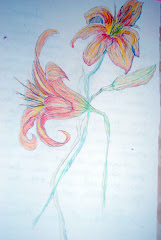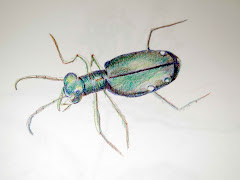


 A few weeks ago, before the snows came, I visited the Pine Barrens in Albany. I’d been hearing about them for years, but had failed to make the trip down there until now. I knew that it was a very similar terrain and habitat to the Wilton Wilderness Preserve and Park (WWPP) in Saratoga County, and there was good reason for this, because both areas had been created in the wake of Glacial Lake Albany, an enormous glacial-melt lake.
A few weeks ago, before the snows came, I visited the Pine Barrens in Albany. I’d been hearing about them for years, but had failed to make the trip down there until now. I knew that it was a very similar terrain and habitat to the Wilton Wilderness Preserve and Park (WWPP) in Saratoga County, and there was good reason for this, because both areas had been created in the wake of Glacial Lake Albany, an enormous glacial-melt lake.Twenty thousand years ago, much of New York State was covered with an up-to-a-mile- thick glacier. About 15,000 years ago, as the temperatures began to rise, and the glacier began to melt, and retreat to the north, the huge amount of water left behind collected in the Hudson Valley, and created Lake Albany, which covered an area from what is now Newberg, NY, to present-day Glens Falls, NY.
Rivers and streams that flowed into Lake Albany carried much glacial sediment: clay, gravel and sand were all dumped into the lake. Variety in the size of the sediments influenced how and where it settled on the lake bottom; and one of its large sand deposits is to be found in this oak-pine savannah.
About 5,000 years ago the water drained from Lake Albany, leaving the sandy bottom exposed to the wind, and other waters that flowed here; together these forces carved out the unique sand dune terrain and steep ridges that are now evident in this area.
The area’s water table, unique soil, and rolling terrain influenced the kind of vegetation found here, and as a result, these two areas became home to many unique and special species: the Karner Blue butterfly (State and Federal Designated Endangered Species); the Frosted Elfin (State-Designated Threatened Species); Blanding’s Turtle (State-Designated Threatened Species); Eastern Spadefoot Toad (State-Designated Species of Special Concern); Eastern Hognose Snake (State-Designated Species of Special Concern); and the Spotted Salamander (State-Designated Species of Special Concern) are found in one, or both of these preserves.
Appalachian Oak-Pine forest is dominant here: White Pine, Pitch Pine, Black Oak, White Oak and Red Maple. Sweetfern, Witch Hazel, and Scrub Oak are the dominant shrubs. Grasses and wildflowers found here are Little Blue-Stem, Blue Lupine, Spreading Dogbane, Butterfly Weed, and New Jersey Tea.
The Albany Pine Bush Preserve (APBP) consists of 3,010 acres, and in 1996, a formal protection plan was adopted by the APBP Commission. This plan proposed to protect this area as a unique ‘inland Pine Barren habitat’.
Unfortunately, before this protection, vast areas and habitat were destroyed through urban sprawl; but, today, threats still exist from habitat fragmentation, roadside practices and land-use conversions.
In addition, many of these plant species have evolved with, and adapted to fire, as a result, they are dependent upon it. Both White-Pine and Pitch Pine have serotinus cones, which means that their cones have a kind of glue on their scales, which can be removed only after they have been exposed to extreme heat, therefore, they can’t release their seeds, and germinate, without fire. Because APBP is cheek-by-jowl with the city of Albany, and fire is seen as a disturbance, it has traditionally been suppressed here. But recently, however, controlled burning is now practiced in the APBP, as can be seen in the accompanying photographs.
The area’s most famous resident: the Karner Blue butterfly (Lycaeides melissa samuelis) has achieved its status as a federally-endangered species due, in large part, to the loss of its host plant, Blue Lupine, which, in turn, has been in decline due to habitat destruction. In addition, natural succession, resulting from fire suppression, has had a detrimental impact on Blue Lupine, as well.
The Karner Blue has lost vast habitat areas and large urban areas such as Chicago and New York have seen complete extinction of the species in their areas. Today the most viable population is to be found in Saratoga County, but it is also one of APBP’s famous residents.








Thanks for all the info on the APBP and the beautiful photos. This is a place I've long wanted to visit. Let's plan a trip there in the spring. Happy New Year to you and yours!
ReplyDelete